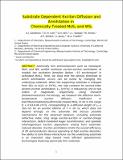Notice
This is not the latest version of this item. The latest version can be found at:https://dspace.mit.edu/handle/1721.1/135970.2
Substrate-Dependent Exciton Diffusion and Annihilation in Chemically Treated MoS 2 and WS 2
| dc.contributor.author | Goodman, AJ | |
| dc.contributor.author | Lien, D-H | |
| dc.contributor.author | Ahn, GH | |
| dc.contributor.author | Spiegel, LL | |
| dc.contributor.author | Amani, M | |
| dc.contributor.author | Willard, AP | |
| dc.contributor.author | Javey, A | |
| dc.contributor.author | Tisdale, WA | |
| dc.date.accessioned | 2021-10-27T20:30:10Z | |
| dc.date.available | 2021-10-27T20:30:10Z | |
| dc.date.issued | 2020 | |
| dc.identifier.uri | https://hdl.handle.net/1721.1/135970 | |
| dc.description.abstract | Copyright © 2020 American Chemical Society. Atomically thin semiconductors such as monolayer MoS2 and WS2 exhibit nonlinear exciton-exciton annihilation at notably low excitation densities (below ∼10 excitons/μm2 in exfoliated MoS2). Here, we show that the density threshold at which annihilation occurs can be tuned by changing the underlying substrate. When the supporting substrate is changed from SiO2 to Al2O3 or SrTiO3, the rate constant for second-order exciton-exciton annihilation, kXX [cm2/s], is reduced by 1 or 2 orders of magnitude, respectively. Using transient photoluminescence microscopy, we measure the effective room-temperature exciton diffusion coefficient in bis(trifluoromethane)sulfonimide-treated MoS2 to be in the range D = 0.03-0.06 cm2/s, corresponding to a diffusion length of LD = 350 nm for an exciton lifetime of τ = 18 ns, which does not depend strongly on the substrate. We discuss possible mechanisms for the observed behavior, including substrate permittivity, long-range exciton-exciton or exciton-charge interactions, defect-mediated Auger recombination, and spatially inhomogeneous exciton populations arising from substrate-induced disorder. Exciton annihilation limits the overall efficiency of 2D semiconductor devices operating at high exciton densities; the ability to tune these interactions via the underlying substrate is an important step toward more efficient optoelectronic technologies featuring atomically thin materials. | |
| dc.language.iso | en | |
| dc.publisher | American Chemical Society (ACS) | |
| dc.relation.isversionof | 10.1021/ACS.JPCC.0C04000 | |
| dc.rights | Creative Commons Attribution-Noncommercial-Share Alike | |
| dc.rights.uri | http://creativecommons.org/licenses/by-nc-sa/4.0/ | |
| dc.source | other univ website | |
| dc.title | Substrate-Dependent Exciton Diffusion and Annihilation in Chemically Treated MoS 2 and WS 2 | |
| dc.type | Article | |
| dc.relation.journal | Journal of Physical Chemistry C | |
| dc.eprint.version | Author's final manuscript | |
| dc.type.uri | http://purl.org/eprint/type/JournalArticle | |
| eprint.status | http://purl.org/eprint/status/PeerReviewed | |
| dc.date.updated | 2021-06-15T15:18:18Z | |
| dspace.orderedauthors | Goodman, AJ; Lien, D-H; Ahn, GH; Spiegel, LL; Amani, M; Willard, AP; Javey, A; Tisdale, WA | |
| dspace.date.submission | 2021-06-15T15:18:20Z | |
| mit.journal.volume | 124 | |
| mit.journal.issue | 22 | |
| mit.license | OPEN_ACCESS_POLICY | |
| mit.metadata.status | Authority Work and Publication Information Needed |
